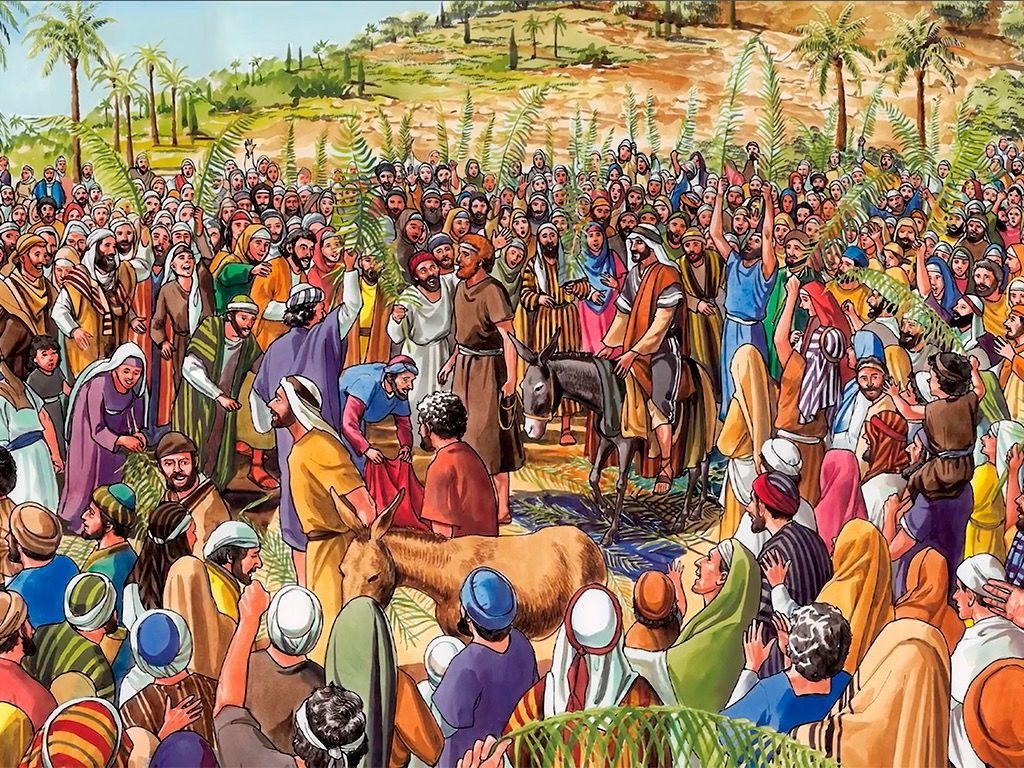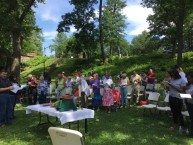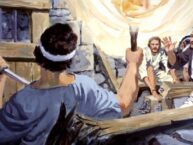 Palm Sunday – March 24, 2024: “Blessed is the one who comes in the name of the Lord!” Amen.
Palm Sunday – March 24, 2024: “Blessed is the one who comes in the name of the Lord!” Amen.
Just a reminder, as I say every year, this should be only Palm Sunday. The passion should not be read here – on Palm Sunday where it really doesn’t belong. Some say that we have always done it that way (meaning it was done that way in their memory). Maybe so, in the Episcopal Church anyway. But, sadly, there is no other reason it became a part of tradition other than many will not make it to the first to parts of the Paschal Triduum service (Maundy Thursday and Good Friday), so we add the passion to this service – because Easter, without Maundy Thursday and Good Friday, is an empty experience. So, we do it. We are always blessed to have the passion brought to life by the Dzieci Theatre, and we change up the order of things, to have that done as the final moment of the service.
So, sticking with text from the liturgy of the Palms, which today is Mark 11:1-11, Jesus tells his disciples to go into the village, untie a colt (a young donkey really), tell folks not to worry – that they are just borrowing it, and then he goes toward Jerusalem riding it as people shout praises of him in the streets. He then goes into the temple, looks around, and heads to Bethany for the night.
After that wild entry into the city – all the palms, and shouts of Hosanna, this is how he ends the day? According the gospel, “…he entered Jerusalem and went into the temple; and when he had looked around at everything, as it was already late, he went out to Bethany with the twelve.”
What was he looking at or for, and why was that such an important detail to note – particularly in this, the Gospel of Mark, written in such a hurry at the time of the 2nd temple destruction (around 68-70 CE).
This gospel author is not one for long narratives as you find in Matthew, or poetic hymns and lengthy discourses as the authors of John provide. Nope – this is the short, sweet, and to the point Gospel of Mark.
In Eastertide, I will be offering an adult formation series on this gospel, using a book called The Gospel of Mark as Story: An Introduction to the Narrative of a Gospel. One of the authors is a friend and terrific Markan scholar. In the book, it says “When we enter the story of the Gospel of Mark, we enter a world of conflict and suspense, a world of surprising reversals and strange ironies, a world of riddles and hidden meanings, a world of subversive actions and political intrigues. And the protagonist – Jesus – is the most surprising of all.”
So, with that in mind, let’s remember the setting of this part of this gospel. Tensions in the city of Jerusalem are at a high at this time each year – during the Passover. Why? Because this is both a time when good and faithful Jewish people flood the city to celebrate this most important time, which just happens to celebrate release from the bondage of the oppressor. In the case of Passover, from Egypt, but it isn’t the sort of story that sits well with the current Empire of Rome. Which is why every year, entering into that same city at that same time is a large group of soldiers and the Roman Governor who ruled under the authority of the Emperor.
This was a difficult time for the Jewish leaders, who hoped to keep the peace with Rome, especially as the Jews have been granted the ability to celebrate their faith traditions (as long as they paid their taxes and stayed out of trouble). Those who didn’t faced terrible persecution, and Pilate, despite the clean-up the authors of the Gospel of John did, was no nice guy. He had brutally crucified thousands in previous years. The answer to his question of “what is truth?” is “you’re a tyrannical nut case Pilate!”
So, tensions are high among Romans and Jews alike – and Jesus then comes into town. He rode a humble donkey, a can’t miss contrast to the steeds being ridden at nearly that same moment on the other end of town by the Empire’s best and brightest. And the people gather in mass shouting Hosanna, claiming him to be their long awaited hope – found in the line of King David – and laying leafy branches before him.
What a scene this must have been. We have indeed entered into “a world of conflict and suspense…surprising reversals and strange ironies, … riddles and hidden meanings, … subversive actions and political intrigues.” What could possibly go wrong?
The stage is set.
It is now dusk.
The people are settling down for the night.
And Jesus goes to the temple and looks around. He then went to Bethany, a nearby town he knew well, to spend the night.
I often have a chance to be alone here – in this sacred space – sometimes at dusk, or at night – the light of the sun fading and its low setting casting colorful shadows on the walls. It offers for me a moment of contemplative prayer. I am called into the stillness before or after the chaos of the day. So, I sometimes wonder if that was this type of moment for him.
But the Greek would tend to move us in a different direction, because the author of this gospel uses the word περιβλέπο to describe what Jesus does in the temple – perí meaning “all-around” and blépō meaning to “look at, or gaze on.” This is used only 7 times in the Christian scriptures, all but one of them in this gospel. But this looking around is a bit more specific than just taking in the surroundings. It signifies that this is an act of closely observing with a sweeping or encompassing look and with high personal involvement or self-interest as expressed in the movement of the person’s eyes.[1]
St. Paul, in the epistle to the Philippians we heard earlier, said “Let the same mind be in you that was in Christ Jesus.” Well, that is meet and right so to do (for all you 1928 prayer book folks).
So, what was Jesus searching so intently for in that moment. What was in his mind?
If we were to continue the story, we find that he returned to Jerusalem the next day, cursing a fig tree along the way for not bearing fruit (a metaphor for what he saw). He entered the temple and angrily overturned the tables of those who had turned that sacred space into a place of profit. This poked an already tense situation in the city, and Jesus wasn’t done yet.
But let’s not get ahead of ourselves. After the craziness of the palm parade, Jesus went to the place where people should be spiritually fed. Where he could be fed. And I suspect he left feeling spiritually hungry. His anger the next day at the fig tree – a symbol of the temple elite – is evidence of that. Whatever he did or did not see, it was clear that he knew what he had to do – but that moment was not the right time – he headed to Bethany to spend the night.
That is what Palm Sunday is supposed to be for us. That moment when we look around and know things need to change, and to prepare ourselves for what is to come.
There is much that we can look around and see, or not see, and know that change – big change – needs to happen.
For we know that this story is not something that happened once so long ago. It is happening now.
Empires that oppress.
Places of worship that do not nourish God’s children.
Jesus betrayed, denied, and crucified.
Because Jesus is the trans-teen left for dead after being savagely beaten. He is the immigrant imprisoned trying to flee persecution. He is the black man tortured and shot by police. He is the gay woman broken hearted that she is unwelcome in the church. He is the terrified and abused Jewish hostage of Hamas. He is the child in Gaza starving amid the rubble and death of the destructive bombing. He is the refugee hoping to find a safe home. He is the Ukrainian soldier fighting to keep her homeland free.
We live in a perpetual Holy Week. We also know that there is good news ahead, but only if we are willing to walk with Jesus into the fullness of this moment – one step at a time.
The procession of the palms is a transition point only, and not the full story. What we will experience in the days to come, like it was for those who were with Jesus that night, will change us, if we let it.
Today, we must have the same mind as Jesus – we must look around – see what is, and what is not – and then go to a place of rest, for there is much to come. Palm Sunday is our time in the temple and in Bethany. Our time to consider what we have seen or not seen, to consider what God calls us to do in response, and to rest for what is to come – what we as the body of Christ will bring about.
Holy Week is a journey we make every year by choice – not because it is the same – but precisely because it is not. How we enter into it, what we hear in it, what we feel going through it, and how we respond to it in the world, will change from year to year because we and the world are never the same from one year to the next. But one thing is for sure, moving through it makes Easter the transformative experience it is meant to be.
Holy Week will challenge you.
Holy Week will engage you.
Holy Week will change you.
If you let it.
I invite you all to the journey of a lifetime.
The rest is up to you.
Amen.
For the audio, click below, or subscribe to our iTunes Sermon Podcast by clicking here (also available on Audible):
[1] https://biblehub.com/greek/4017.htm
The Rev. Diana L. Wilcox
Christ Church in Bloomfield & Glen Ridge
March 31, 2024
Palm Sunday
1st Reading – Isaiah 50:4-9a
Psalm 31:9-16
2nd Reading – Philippians 2:5-11
Gospel – Mark 11:1-11 & Mark 14:1-11





